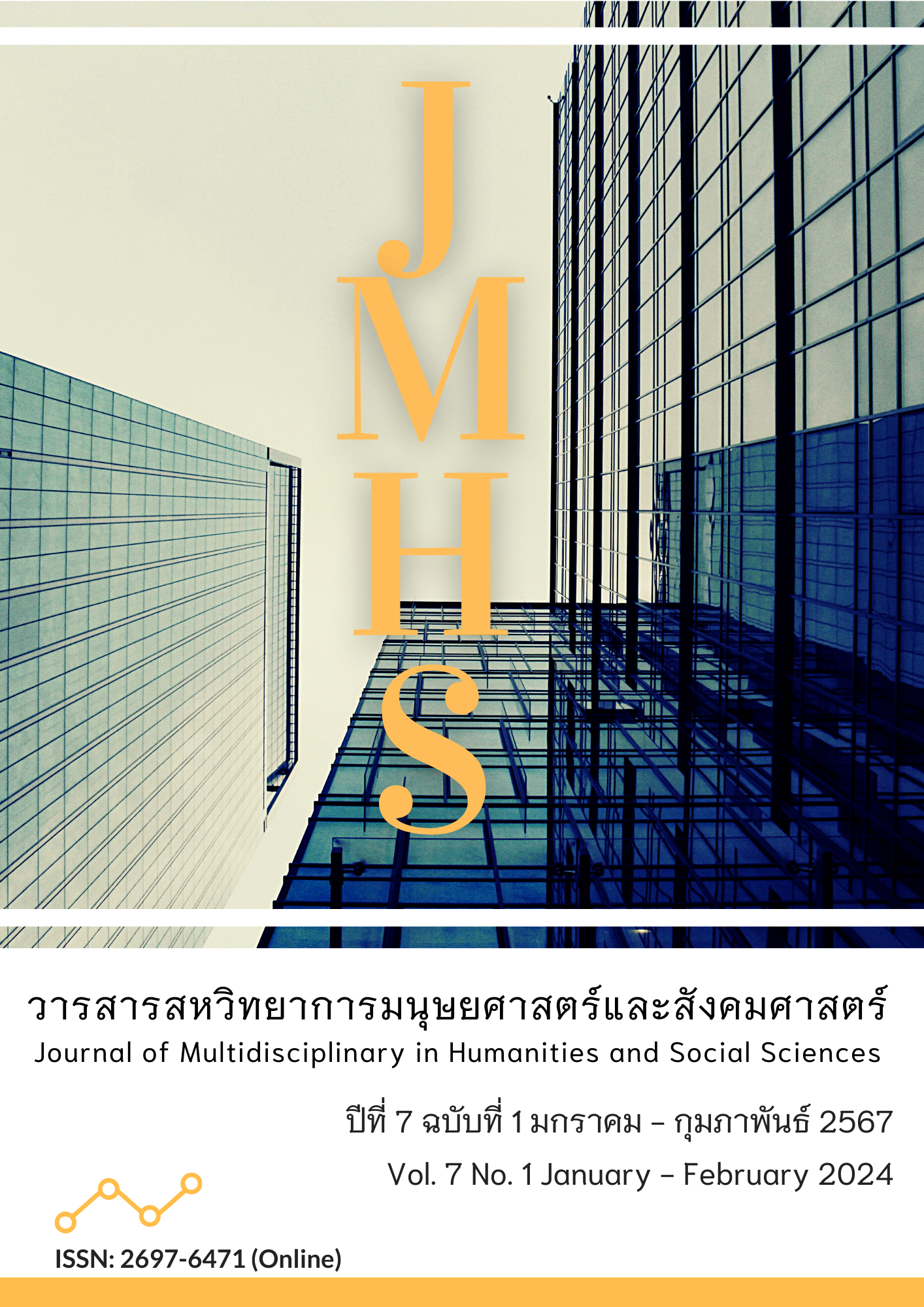A Model of Immunization and Creative Resolving Conflicts Based on The Four Noble Truths of Vulnerable Youths in The Northeast
Main Article Content
Abstract
Social inequality and vulnerability among youth, family conflicts, power relationships, bullying, corruption, humiliation, and suffering. Regressive classes, frequent absences, dropping out of school midway. Teen pregnancy is to create and assess a model of immunization and creative resolution to conflicts among vulnerable youths in the Northeast based on the Four Noble Truths in Buddhism and assess its appropriate conformity. The development of the model was based on the specialists’s interviews secured by Delphi techniques and empirical data. A mixed research methodology was employed, and the site covers the secondary schools under the Northeastern Secondary Education Office. The qualitative target group was 18 specialists, whereas the quantitative target group comprises school administrators, teachers, and students, totaling 300 in number. Two devices were used, comprising (1) an open-ended questionnaire based on Delphi techniques and (2) a five-scale questionnaire. The information analysis was implemented by the statistical instruments, namely mean and S.D. in terms of quantitative aspects and descriptive explanation in qualitative terms.
The results can be summarized as follows: 1) For the first target, it was found that the information collected from interviews and questionnaires can be classified into 4 areas as follows: (1) Problem as suffering (Dukkha) is divided into 10 categories. (2) Causes of the Problem or Causes of Suffering (Samudaya), divided into 11 categories. (3) Data collection and analysis to achieve the target, or cessation of suffering (Nirodha), divided into 4 targets. (4) Conclusion and recommendation: forward the next target or Way to Cessation of Suffering (Magga), comprising 8 guidelines, 3 activities (Sila, Samadhi, and Panna), and 6 measures. 2) For the second target, it was found that the assessment of decency and conformity of the model (33 items) stands at the ‘MUCH’ level ( = 4.05. S.D. = 0.48).
The knowledge acquired is that the Four Noble Truths can be appropriately applied to resolve conflicts among vulnerable youths. As a matter of fact, suffering is the conflict; Samudaya is the cause of the conflict; Nirodha is immunity to, or cessation of, the conflict; and Magga is the means or measure to cease the conflict, or, in other words, the method to create immunity against the conflict.
Article Details

This work is licensed under a Creative Commons Attribution-NonCommercial-NoDerivatives 4.0 International License.
Views and opinions appearing in the Journal it is the responsibility of the author of the article, and does not constitute the view and responsibility of the editorial team.
References
ชิรวัฒน์ นิจเนตร. (2560). การวิจัยพัฒนารูปแบบทางสังคมศาสตร์และการศึกษา. วารสารราชภัฏสุราษฎร์ธานี, 4(2), 71-102.
ทิศนา แขมมณี. (2551). รูปแบบการเรียนการสอน ทางเลือกที่หลากหลาย. กรุงเทพฯ: จุฬาลงกรณ์มหาวิทยาลัย.
นพดล กรรณิกา. (2552). สถานการณ์การใช้ความรุนแรงในกลุ่มเด็กและเยาวชน. ศูนย์วิจัยความสุขชุมชน, มหาวิทยาลัยอัสสัมชัญ. สืบค้นเมื่อ 1 มีนาคม 2566, จาก http://www.ryt9.com/s/abcp/524293
บุญมี โททำ. (2560). พุทธวิธีในการแก้ไขปัญหาความขัดแย้งทางสังคม. วารสารวิชาการมหาวิทยาลัยราชภัฏเพชรบุรี, 7(2), 4-11.
พรชัย ขันตี. (2553). ทฤษฎีอาชญาวิทยา: หลักการงานวิจัยและนโยบายประยุกต์. กรุงเทพฯ: สุเนตรฟิล์ม.
พระมหาศิวะเสน ญาณเมธี, บุญมี เรณยอด และ สุทธิพงษ์ ศรีวิชัย. (2561). รูปแบบการบริหารจัดการความขัดแย้งในพระพุทธศาสนา: วิเคราะห์จากพระไตรปิฎก. Veridian E-Journal, Silpakorn University (ฉบับภาษาไทย สาขามนุษยศาสตร์สังคมศาสตร์และศิลปะ), 11(2), 2310-2326.
พระศรีรัชมงคลบัณฑิต. (2563). พุทธวิธีในการแก้ไขปัญหาการทะเลาะวิวาท. วารสาร มจร. บาลีศึกษาพุทธโฆสปริทรรศน์, 6(1), 1-16.
ยิ่งภัสสร พิมพิสัย. (2555). ศึกษาสภาพปัญหาและแนวทางแก้ไขปัญหาการทะเลาะวิวาทของนักเรียนอาชีวศึกษาในเขตกรุงเทพมหานครและปริมณฑล(รายงานวิจัย). วิทยาลัยเทคนิคดอนเมือง.
รัตนะ บัวสนธ์. (2552). การวิจัยและพัฒนานวัตกรรมการศึกษา. กรุงเทพฯ: คำสมัย.
วรรณวดี พูลพอกสิน. (2563). บทเรียนรู้จากการใช้วิธีการวิจัยในตัวอย่างเปราะบาง: จากทฤษฎีสู่การปฏิบัติ. หนังสือรวมบทความสัมมนาทางวิชาการ เนื่องในโอกาสการสถาปนาคณะสังคมสงเคราะห์ศาสตร์ มหาวิทยาลัยธรรมศาสตร์ ครบรอบปีที่ 66, วันที่ 24 มกราคม พ.ศ. 2563. น. 223-234.
วาโร เพ็งสวัสดิ์. (2553). การวิจัยพัฒนารูปแบบ. วารสารมหาวิทยาลัยราชภัฏสกลนคร, 2(4), 1-15.
สำนักงานคณะกรรมการพัฒนาเศรษฐกิจและสังคมแห่งชาติ. (2560). แผนพัฒนาเศรษฐกิจและสังคมแห่งชาติ ฉบับที่ 12 ( พ.ศ. 2560– 2564 ). กรุงเทพฯ: สำนักนายกรัฐมนตรี.
สุดาพร สินประสงค์. (2550). สาเหตุและแนวทางแก้ไขปัญหาการทะเลาะวิวาทของนักเรียน นักศึกษา ระดับอาชีวศึกษาประเภทช่างอุตสาหกรรมในเขตกรุงเทพมหานคร(วิทยานิพนธ์ปริญญาครุศาสตร์มหาบัณฑิต). มหาวิทยาลัยราชภัฎธนบุรี.
อัณณพ ชูบำรุง และ อุนิษา เลิศโตมรสกุล. (2555). อาชญากรรมและอาชญาวิทยา. กรุงเทพฯ: จุฬาลงกรณ์มหาวิทยาลัย.
Good, C. V. (1973). Dictionary of Education. (3rd ed.). New York: McGraw-Hill.
Hansen, L. (2007). Beliefs, Doubts and Learning. Valuing Macroeconomic Risk. American Economic Review, 97(2), 1-30.
Steiner, E. (1988). Methodology of Theory Building. Sydney: Educology Research Associates.
Swanson, C. R., Chamelin, N., Territo, L., & Taylor, R. W., (2010). Criminal Investigation Ninth. (9th ed.). New York: McGraw-Hill.
Willer, D. (1968). Scientific Sociology: Theory and Method. Englewood Cliffs, New Jersey: Prentice-Hall.


